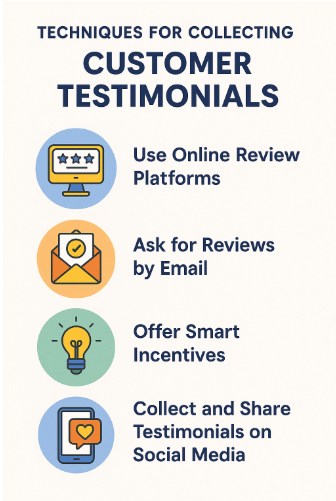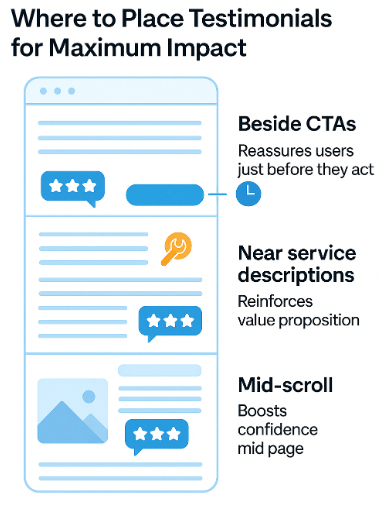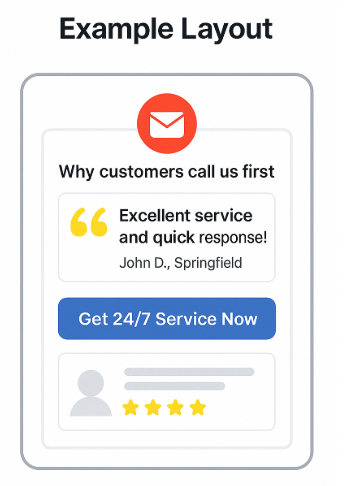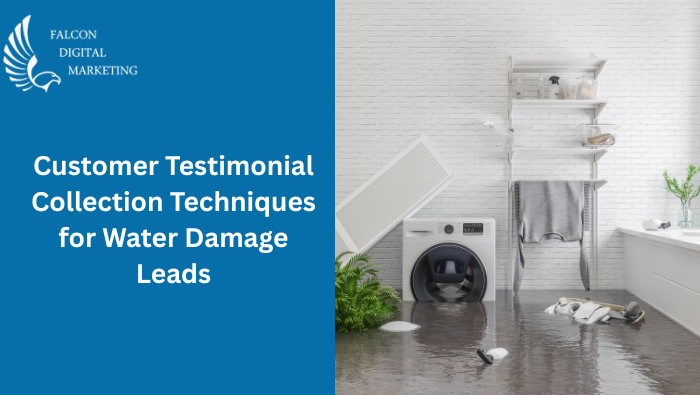Customer testimonials are one of the most effective tools for generating more water damage leads. Real stories from past clients build trust fast, especially when people are stressed and need help right away.
When shared on landing pages, in ads, on social media, or in follow-up emails, real client stories show proof of quality and make it easier for prospects to choose your service. This can make the difference between someone clicking “call” or moving on.
How Testimonials Help You Generate More Water Damage Leads
At Falcon Digital Marketing, we’ve seen firsthand how testimonials help restoration businesses grow.
Here’s why they work: when someone experiences water damage, they’re under pressure. They don’t want to take a risk. They want to know the company they’re hiring has done the job before, and done it well.
A strong testimonial does more than say “great service.” It tells a story that shows you can deliver.
Let’s break down how to collect and use testimonials that actually drive water damage leads.
Techniques You Can Use to Collect Customer Testimonials
Getting more reviews starts with making it easy for your customers to leave one.
Most water damage restoration clients don’t think about writing a testimonial unless you guide them. That doesn’t mean they don’t want to help. It just means you need a system.

Let’s walk through the key methods you can use right now.
1. Use Online Review Platforms to Your Advantage
Platforms like Google Reviews, Yelp, and Facebook are the first place people look when deciding who to hire.
That’s why getting testimonials posted there isn’t optional. It’s part of your lead generation system.
If you’re not already doing it, start here:
- Claim your Google Business Profile
Make sure your hours, service area, and phone number are correct. A complete profile builds trust. - Add direct review links
Send customers a short link that takes them straight to the review box. No one wants to click through five pages. - Respond to every review
Good or bad, your reply shows that you care. This builds credibility with potential clients.
Here’s what a strong online review presence can do for your lead funnel:

2. Ask for Reviews by Email (The Right Way)
Email is still one of the best tools for collecting feedback, especially when paired with timing and personalization.
Here’s what works:
- Send the request within 24-48 hours
This keeps the job fresh in their mind. If they’re happy, they’ll want to say so. - Use their name and service type
Instead of “Please leave a review,” say, “Hi Sarah, thanks for trusting us with your basement cleanup. We’d love to hear how we did.” - Keep the Call-to-Action (CTA) simple
One button. One link. That’s it.
Also, follow up once if they don’t respond. Sometimes it takes two touches to get results.
Well-written testimonial request emails are short, helpful, and show appreciation. They also remind the client that their opinion matters.
3. Offer Smart Incentives That Encourage Feedback
Incentives work, but only if you do them right.
You’re not buying reviews. You’re thanking your customer for sharing their experience.
Here are a few ethical options that build engagement:
- Next-service discount
Offer 10% off their next job or inspection if they leave a verified review. - Quarterly prize drawings
Put all reviewers into a raffle. Keep it light and fun. - Charitable tie-ins
Let them know you’ll donate $5 to a local relief fund for every review received that month.
Here’s how different incentives stack up:

Make sure to disclose any rewards clearly. The goal is to keep reviews authentic and trustworthy.
4. Collect and Share Testimonials on Social Media
Social media isn’t just for brand awareness. It’s also a great channel for review collection and visibility.
Use it to:
- Encourage clients to tag your business
Ask them to post before-and-after photos or a quick story. Provide a hashtag for easy tracking. - Re-share reviews in your posts
A simple quote image or video clip can build serious credibility, especially when paired with a photo of the completed job. - Ask for feedback in DMs
If a client compliments you on Instagram, message them back and ask if you can share that comment as a testimonial.
Don’t underestimate the power of video, either. A 30-second phone clip of a customer saying, “They showed up fast, explained everything, and cleaned up perfectly,” can outperform a full paragraph on your website.
Social media review strategies also help you reach new people who aren’t searching on Google yet but are browsing platforms like Facebook or TikTok.
How to Use Customer Testimonials to Generate Water Damage Leads
Customer testimonials do more than boost your reputation. They support your lead generation system.
When used strategically, testimonials guide potential clients toward action. That includes booking service, filling out a quote request, or choosing you over a competitor.
Below are practical ways to embed testimonials into your marketing strategy.
1. Place Testimonials on Key Areas of Your Landing Pages
Your landing page has one job: convert visitors into leads. The right testimonial at the right moment builds confidence and pushes people toward the next step.
Think about where visitors feel unsure. That’s where social proof belongs.
Try this layout:

Also, use different formats depending on your audience. For example:
- Text quotes with names and locations
- Star ratings with review excerpts
- Before-and-after project photos with captions
If you use a Customer Relationship Management (CRM), tag customer feedback so you can match the right quote with the right service page. That keeps your messaging targeted and relevant.
2. Add Testimonials to Your PPC Ads
In water damage restoration, trust is everything. Most people search during a stressful situation, and your ad has seconds to earn a click.
That’s why reviews can be powerful in paid ads. A short quote or high review rating can turn a scroll into a conversion.
Here’s how to integrate testimonials in ads:
- Include star ratings using ad extensions on Google Ads
- Use one-line quotes in your ad copy like “Fast and professional during our basement flood”
- A/B test ads with and without testimonials to measure performance
Example:
Ad A: “24/7 Water Damage Cleanup. Fast Local Response.”
Ad B: “Rated 4.9 Stars on Google. 24/7 Water Damage Cleanup.”
If Ad B gets more clicks, you’ve validated the impact of social proof.
Add visuals too when possible. A client photo next to their quote can increase engagement, especially on platforms like Facebook and Instagram.
3. Post Testimonials Across Your Social Media Channels
People scroll fast on social platforms. That means your testimonials need to be eye-catching, short, and relatable.
Here’s what works well:
- Video testimonials where a homeowner explains how your team helped
- Quote cards with a photo of the job site or team
- Story highlights that feature ongoing feedback
Encourage customers to tag you in their own posts. This user-generated content can be shared to build brand credibility.
Platform-specific tips:

Social content can also drive engagement from future clients who are not actively searching on Google but are scrolling for solutions or referrals.
4. Feature Testimonials in Email Marketing Campaigns
Email campaigns can turn past clients into repeat business and bring in new leads when testimonials are included.
The goal is to share real experiences that help readers trust your brand.
Use testimonials in:
- Promotional emails: Show how others benefited from seasonal offers
- Service follow-ups: Reinforce quality with a short quote and call-to-action
- Welcome emails: Build confidence for new subscribers or leads
Here’s how to make testimonials more effective in emails:
- Placement
Keep the testimonial close to your CTA. It adds credibility at the exact decision point. - Length
Use 1-2 sentence quotes. Long paragraphs get skipped. - Design
Add a photo, star rating, or icon to draw the eye to the quote. - Segmentation
Match the testimonial to the email topic. If the email is about emergency service, highlight a review about fast response.
Here’s an example layout:

Email marketing works best when it feels human. Adding the voice of your clients does just that.
Bottom Line:
You don’t need hundreds of testimonials to make an impact. Just a few well-placed, authentic quotes can lift your conversion rates across every channel.
We help businesses like yours systemize testimonial collection and place them where they drive the most action, in landing pages, ads, emails, and more.
Let us know if you’d like help turning customer feedback into a steady stream of water damage leads.
FAQ
How can water damage leads benefit from customer testimonials?
Testimonials build trust fast.
Most people looking for water damage help are in a rush. They need to know you’re reliable. When they read a review from someone else who had a great experience, it makes your business feel safe and proven.
Testimonials show you’ve handled similar problems before and know how to help.
Why are testimonials from water damage leads so important?
Not all reviews have the same impact.
Water damage clients usually deal with emergency situations. If you respond fast and solve the problem, that story matters.
Testimonials from those jobs help future leads understand what to expect and why they should choose you.
Ask for specific stories, not just praise. A quick review saying “they arrived in 45 minutes and handled the flood cleanup perfectly” has more weight than “great job.”
Do customer testimonials help generate new water damage leads?
Yes, they do.
Most new leads will check reviews before calling. They’ll search online, click your ad, or visit your website. Along the way, testimonials help them feel more confident.
That trust is what gets them to act.
If you consistently use customer feedback across your digital marketing, you’ll bring in better leads and close more jobs.
How can testimonials improve the success of a water damage business?
Real stories from real customers help you stand out.
They make your business look dependable, fast, and trustworthy. Over time, that leads to:
- More leads from local searches
- Higher conversion rates from ads and website visits
- Stronger relationships with referral partners like property managers
- A brand people talk about and return to

